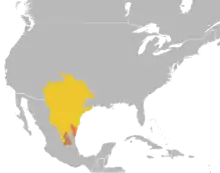Hypsiglena jani
Hypsiglena jani, commonly known as the Texas night snake or the Chihuahuan night snake, is a small species of mildly venomous snake in the family Colubridae. The species is native to the southwestern United States and adjacent northeastern Mexico.
| Hypsiglena jani | |
|---|---|
 | |
| Scientific classification | |
| Domain: | Eukaryota |
| Kingdom: | Animalia |
| Phylum: | Chordata |
| Class: | Reptilia |
| Order: | Squamata |
| Suborder: | Serpentes |
| Family: | Colubridae |
| Genus: | Hypsiglena |
| Species: | H. jani |
| Binomial name | |
| Hypsiglena jani (Dugès, 1865) | |
 | |
| The distribution of Hypsiglena jani (brown), which now includes the two former subspecies Hypsiglena torquata dunklei (orange), and Hypsiglena torquata texana (yellow). | |
| Synonyms | |
| |
Etymology
The epithet, jani, is in honor of Italian taxonomist Giorgio Jan.[8]
Description
H. jani grows from 10 to 16 inches (25 to 41 centimetres) in total length (including tail), record 20 inches (51 cm).[9] It is typically a light gray or tan in color, with dark brown or dark gray blotching down the back, and has an unmarked underside. It has smooth dorsal scales. The eye has a vertically elliptical pupil. H. jani is rear-fanged, and is considered to be venomous, though it is not dangerous to humans.
Behavior
As the common names imply, H. jani is a primarily nocturnal snake.
Diet
The diet of H. jani consists of primarily lizards, but it will also eat smaller snakes and occasionally soft bodied insects.
Habitat
H. jani prefers semi-arid habitats with rocky soils.
Reproduction
H. jani is an oviparous species that breeds in the spring rainy season, laying 4-6 eggs that take approximately 8 weeks to incubate before hatching. The eggs average 27 mm (1.1 in) long by 10 mm (3⁄8 in) wide. The hatchlings are about 15 cm (5.9 in) in total length.[6]
Geographic range
H. jani ranges from southern Kansas to southern Colorado, and south throughout New Mexico, the western half of Texas to central Mexico.
Subspecies
Three subspecies are recognized as being valid, including the nominotypical subspecies.[2]
- Hypsiglena jani dunklei Taylor, 1938
- Hypsiglena jani jani (Dugès, 1865)
- Hypsiglena jani texana Stejneger, 1893
Nota bene: A trinomial authority in parentheses indicates that the subspecies was originally described in a genus other than Hypsiglena.
References
- Hammerson, G.A. (2019). "Hypsiglena jani". IUCN Red List of Threatened Species. 2019: e.T90067384A90067431. Retrieved 2 December 2021.
- "Hypsiglena jani ". The Reptile Database. www.reptile-database.org.
- Stejneger L, Barbour T (1917). A Check List of North American Amphibians and Reptiles. Cambridge, Massachusetts: Harvard University Press. 125 pp. (Hypsiglena ochrorhynchus texana, p. 93).
- Taylor EH (1938). "On Mexican Snakes of the Genera Trimorphodon and Hypsiglena ". Univ. Kansas Sci. Bull. 25 (16): 357-383. (Hypsiglena torquata dunklei, new subspecies, pp. 374-375 + Plate XXXVII, figure 1).
- Global Names Index. gni.globalnames.org.
- Wright AH, Wright AA (1957). Handbook of Snakes of the United States and Canada. Ithaca and London: Comstock Publishing Associates, a division of Cornell University Press. 1,105 pp. (in 2 volumes) (Hypsiglena torquata texana, pp. 326-330, Figure 101 + Map 30 on p. 315).
- Mulcahy DG (2007). "Molecular systematics of neotropical cat-eyed snakes: a test of the monophyly of Leptodeirini (Colubridae: Dipsadinae) with implications for character evolution and biogeography". Biol. J. Linnaean Society 92: 483-500. (Hypsiglena jani).
- Beolens, Bo; Watkins, Michael; Grayson, Michael (2011). The Eponym Dictionary of Reptiles. Baltimore, Maryland: Johns Hopkins University Press. xiii + 296 pp. ISBN 978-1-4214-0135-5. (Hypsiglena jani, p. 133).
- Conant R (1975). A Field Guide to Reptiles and Amphibians of Eastern and Central North America, Second Edition. Boston: Houghton Mifflin. xviii + 429 pp. + Plates 1-48. ISBN 0-395-19979-4 (hardcover), ISBN 0-395-19977-8 (paperback). (Hypsiglena torquata texana, p. 217 + Plate 33 + Map 170).
Further reading
- Dugès A (1865). "Du Liophis janii". Mém. Acad. Sci. Lett. Montpellier 6: 32–33. (Liophis jani, new species). (in French).
- Powell R, Conant R, Collins JT (2016). Peterson Field Guide to Reptiles and Amphibians of Eastern and Central North America, Fourth Edition. Boston and New York: Houghton Mifflin Harcourt. xiv + 494 pp., 47 plates, 207 figures. ISBN 978-0-544-12997-9. (Hypsiglena jani, pp. 409–410 + Plate 39).
- Stejneger L (1893). "Annotated List of the Reptiles and Batrachians Collected by the Death Valley Expedition in 1891, with Descriptions of New Species". North American Fauna 7: 159–228. (Hypsiglena texana, new species, p. 205).
- Tanner WW (1944). "A Taxonomic Study of the Genus Hypsiglena ". Great Basin Naturalist 5 (3 & 4): 25–92. (Hypsiglena dunklei, p. 48; H. ochrorhynchus janii, pp. 48–51; and H. o. texana, pp. 51–54).
